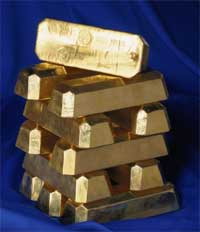Investors plow money into gold
Investors who smell an impending interest rate cut at Wall Street are not waiting around for the central bank.

They have been pulling their money out of investments that might be hit by lower interest rates, including the dollar, and plowing it into gold. That hasty exit has created a mini gold rush, sending the price of gold through the psychological barrier of $700 an ounce to its highest levels in 16 months.
"It makes less sense to own bonds, to own a bank account paying interest because you're getting squeezed. The way to play a negative interest rate environment is to own hard assets," said Thomas Winmill, president of the Midas Fund. "We may be at a juncture where people say 'I don't want to own CDOs anymore, I want to own something tangible,"' he said, referring to collateralized debt obligations, a mortgage-related investment that has fallen out of favor amid increasing credit market problems.
Mounting unease about rates and easier access have made gold a natural choice for some investors. Besides mutual funds that might invest in gold producers, exchange-traded funds now invest directly in gold, making it easier for everyday investors to get their hands on gold. An exchange traded fund, or ETF, is a security that tracks an underlying benchmark much like an index mutual fund but trades like a stock on an exchange. It can therefore be bought and sold during the trading day.
ETFs like StreetTRACKS Gold Shares and the iShares COMEX Gold Trust have become popular because they allow investors exposure to the movement of the price of gold without having to deal with the intricacies of the futures markets.
Owning gold during times of uncertainty can be reassuring.
"Gold is always worth something," said Jim Vail, senior vice president and portfolio manager for the ING Global Natural Resources Fund, comparing gold favorably to many stocks rendered essentially worthless by the dot-com bust of early in the decade. "Even if you had gold at that time and it was at $250 an ounce, it was worth something," he said. Indeed, in 1999, gold hit $249 and tested that level again in 2001.
"Everything I've seen suggests we could hit $750 before this is over."
But before becoming too excited, investors should consider what sharp increases in gold often mean: Investments elsewhere could be in trouble.
"Gold has never been traditionally a way to make money, it's been a way to preserve wealth," Winmill said.
Still, with gold starting 2007 at $630 an ounce, it is up about 12 percent for the year. Compare that with the Standard & Poor's 500 index, the stock market benchmark favored by many professionals, which is up about 2.5 percent for the year.
Most investment pros recommend investors put no more than 5 percent to 10 percent of their investments in gold. Gold prices, like those of many commodities, are volatile, so it makes sense to take a broad view, observers say.
"If you want to play the gold market, play it like Wayne Gretzky: Look to where it's going to be," said Winmill, referring to the star hockey player.
Even short-term developments can favor gold, Vail said, noting that the approaching wedding season in India is driving up worldwide demand.
Recent upheavals in global markets might have reminded some investors, perhaps belatedly, to be sure they are properly diversified.
"When you have volatility you actually have people thinking about their investments. I think that's a good thing," said Axel Merk, who runs the Merk Hard Currency Fund and has long been uneasy about the prospects for the dollar. He expects gold investments will continue to attract investors because he does not see a quick end to volatility in other markets.
There is an old adage on Wall Street: "Put 10 percent of your money in gold and hope it doesn't work."
At least that is of some comfort to gold investors amid the recent uncertainty.
Subscribe to Pravda.Ru Telegram channel, Facebook, RSS!


